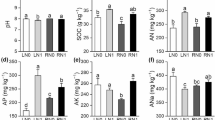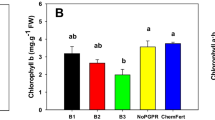Abstract
Purpose
Phosphorus (P) and potassium (K) are two important essential nutrient elements for plant growth and development but their availability is often limited in calcareous soils. The objective of this study was to determine the effects of applying microbial inoculants (MI, containing effective strains of Bacillus megaterium and Bacillus mucilaginous) on the availability of P and K, plant growth, and the bacterial community in calcareous soil.
Materials and methods
A greenhouse experiment was conducted to explore the effects of the addition of MI (control: without MI addition; treatment: with MI addition at the rate of 60 L ha−1) on the concentrations of P and K in soil and plant, soil bacterial community diversity and composition, and chili pepper (Capsicum annuum L.) growth.
Results and discussion
The results showed that MI inoculation significantly increased the fruit yields by 28.5% (p < 0.01), available P and K in the rhizosphere soil by 32.1% and 28.1% (p < 0.05), and P and K accumulation in the whole plants by 40.9% and 40.2%, respectively (p < 0.05). Moreover, high-throughput sequencing revealed that Proteobacteria, Acidobacteria, Bacteroidetes, Chloroflexi, and Gemmatimonadetes were the dominant phyla of soil bacteria. MI application did not significantly impact the diversity and composition of soil bacterial communities, but increased relative abundances of bacterial genera Flavobacterium responsible for promoting root development across growing stages (p < 0.05), and changed the soil bacterial community structure associated closely with soil properties of available P, K, and pH in soil.
Conclusions
The application of MI improved the bioavailability of P and K and plant growth due to its impact on the soil bacterial community structure.




Similar content being viewed by others
References
Abou-el-seoud, Abdel-megeed A (2012) Impact of rock materials and biofertilizations on P and K availability for maize (Zea maize) under calcareous soil conditions. Saudi J Biol Sci 19:55–63
Ahmad M, Nadeem SM, Naveed M, Zahir ZA (2016) Potassium-solubilizing bacteria and their application in agriculture. In: Meena VS, Maurya BR, Verma JP, Meena RS (eds) Potassium solubilizing microorganisms for sustainable agriculture. Springer, New Delhi, pp 293–313
Ambrosini A, Souza RD, Passaglia LMP (2016) Ecological role of bacterial inoculants and their potential impact on soil microbial diversity. Plant Soil 400:1–15
Basak BB, Biswas DR (2010) Co-inoculation of potassium solubilizing and nitrogen fixing bacteria on solubilization of waste mica and their effect on growth promotion and nutrient acquisition by a forage crop. Biol Fertil Soils 46:641–648
Brockett BFT, Prescott CE, Grayston SJ (2012) Soil moisture is the major factor influencing microbial community structure and enzyme activities across seven biogeoclimatic zones in western Canada. Soil Biol Biochem 44:9–20
Chaer G, Fernandes M, Myrold D, Bottomley P (2009) Comparative resistance and resilience of soil microbial communities and enzyme activities in adjacent native forest and agricultural soils. Microb Ecol 58:414–424
Das I, Pradhan M (2016) Potassium-solubilizing microorganisms and their role in enhancing soil fertility and health. In: Meena VS, Maurya BR, Verma JP, Meena RS (eds) Potassium solubilizing microorganisms for sustainable agriculture. Springer, New Delhi, pp 281–291
Etesami H, Emami S, Alikhani HA (2017) Potassium solubilizing bacteria (KSB): mechanisms, promotion of plant growth, and future prospects—a review. J Soil Sci Plant Nutr 17:897–911
Garbeva P, Postma J, Van Veen JA, Van Elsas JD (2006) Effect of above-ground plant species on soil microbial community structure and its impact on suppression of Rhizoctonia solani AG3. Environ Microbiol 8:233–246
Han HS, Lee KD (2006) Effect of co-inoculation with phosphate and potassium solubilizing bacteria on mineral uptake and growth of cayenne pepper and cucumber. Plant Soil Environ-UZPI (Czech Republic) 52:130–136
Hartmann A, Schmid M, Tuinen DV, Berg G (2009) Plant-driven selection of microbes. Plant Soil 321:235–257
Ibrahim HIM, Zaglol MMA, Hammad AMM (2010) Response of balady guava trees cultivated in sandy calcareous soil to biofertilization with phosphate dissolving bacteria and/or VAM fungi. J Am Sci 6:399–404
Ji GH, Wei LF, He YQ, Wu YP, Bai XH (2008) Biological control of rice bacterial blight by Lysobacter antibioticus strain 13-1. Biol Control 45:288–296
Khadem A, Raiesi F (2019) Response of soil alkaline phosphatase to biochar amendments: changes in kinetic and thermodynamic characteristics. Geoderma 337:44–54
Lauber CL, Hamady M, Knight R, Fierer N (2009) Pyrosequencing-based assessment of soil pH as a predictor of soil bacterial community structure at the continental scale. Appl Environ Microbiol 75:5111–5120
Li BW (2014) Safe and efficient vegetables fertilization. China Agriculture Press, Beijing (in Chinese)
Li Y, Chen L, Wen H (2015) Changes in the composition and diversity of bacterial communities 13 years after soil reclamation of abandoned mine land in eastern China. Ecol Res 30:357–366
Ling N, Deng K, Song Y, Wu Y, Zhao J, Raza W, Huang QW, Shen QR (2014) Variation of rhizosphere bacterial community in watermelon continuous mono-cropping soil by long-term application of a novel bioorganic fertilizer. Microbiol Res 169:570–578
Mori H, Maruyama F, Kato H, Toyoda A, Dozono A, Ohtsubo Y, Nagata Y, Fujiyama A, Tsude M, Kurokawa K (2013) Design and experimental application of a novel non-degenerate universal primer set that amplifies prokaryotic 16s rRNA genes with a low possibility to amplify eukaryotic rRNA genes. DNA Res 21:217–227
Nath D, Maurya BR, Meena VS (2017) Documentation of five potassium-and phosphorus-solubilizing bacteria for their K and P-solubilization ability from various minerals. Biocatal Agric Biotechnol 10:174–181
Pande A, Pandey P, Mehra S, Singh M, Kaushik S (2017) Phenotypic and genotypic characterization of phosphate solubilizing bacteria and their efficiency on the growth of maize. J Genet Eng Biotechnol 6:1–13
Postma J, Stevens LH, Wiegers GL, Davelaar E, Nijhuis EH (2009) Biological control of Pythium aphanidermatum in cucumber with a combined application of Lysobacter enzymogenes strain 3.1 T8 and chitosan. Biol Control 48:301–309
Rafique M, Sultan T, Ortas I, Chaudhary HJ (2017) Enhancement of maize plant growth with inoculation of phosphate-solubilizing bacteria and biochar amendment in soil. Soil Sci Plant Nutr 63:460–469
Roberts TL, Johnston AE (2015) Phosphorus use efficiency and management in agriculture. Resour Conserv Recycl 105:275–281
Rousk J, Bååth E, Brookes PC, Lauber CL, Lozupone C, Caporaso JG, Knight R, Fierer N (2010) Soil bacterial and fungal communities across a pH gradient in an arable soil. ISME J 4:134–151
Shanware AS, Kalkar SA, Trivedi MM (2014) Potassium solublisers: occurrence, mechanism and their role as competent biofertilizers. IJCMAS 3:622–629
Shen Z, Wang D, Ruan Y, Xue C, Zhang J, Li R, Shen Q (2014) Deep 16S rRNA pyrosequencing reveals a bacterial community associated with banana Fusarium wilt disease suppression induced by bio-organic fertilizer application. PLoS One 9:e98420
Singh H, Reddy MS (2011) Effect of inoculation with phosphate solubilizing fungus on growth and nutrient uptake of wheat and maize plants fertilized with rock phosphate in alkaline soils. Eur J Soil Biol 47:30–34
Smets W, Leff JW, Bradford MA, McCulley RL, Lebeer S, Fierer N (2016) A method for simultaneous measurement of soil bacterial abundances and community composition via 16S rRNA gene sequencing. Soil Biol Biochem 96:145–151
Supanjani HH, Jung JS, Lee KD (2006) Rock phosphate-potassium and rock-solubilising bacteria as alternative, sustainable fertilizers. Agron Sustain Dev 26:233–240
Trabelsi D, Mengoni A, Ben AH, Mhamdi R (2011) Effect of on-field inoculation of Phaseolus vulgaris with rhizobia on soil bacterial communities. FEMS Microbiol Ecol 77:211–222
Tsukanova KA, Meyer JJM, Bibikova TN (2017) Effect of plant growth-promoting rhizobacteria on plant hormone homeostasis. South Afr J Bot 113:91–102
Verbon EH, Liberman LM (2016) Beneficial microbes affect endogenous mechanisms controlling root development. Trends Plant Sci 21:218–229
Wang X, Zou C, Zhang Y, Shi X, Liu J, Fan S, Wu C (2018) Environmental impacts of cayenne pepper (Capsicum annuum L) production affected by nutrient management: a case study in southwest China. J Clean Prod 171:934–943
Wu K, Yuan SF, Wang LL, Shi JX, Zhao J, Shen B, Shen QR (2014) Effects of bio-organic fertilizer plus soil amendment on the control of tobacco bacterial wilt and composition of soil bacterial communities. Biol Fertil Soils 50:961–971
Wu Y, Zhao C, Farmer J, Sun J (2015) Effects of bio-organic fertilizer on cayenne pepper growth and Fusarium wilt biocontrol. Sci Hortic 193:114–120
Wu B, Wang X, Yang L, Yang H, Zeng H, Qiu YM, Wang CJ, Yu J, Li JP, Xu DH, He ZL, Chen SW (2016) Effects of Bacillus amyloliquefaciens ZM9 on bacterial wilt and rhizosphere microbial communities of tobacco. Appl Soil Ecol 103:1–12
Xue QY, Ding GC, Li SM, Yang Y, Lan CZ, Guo JH, Smalla K (2013) Rhizocompetence and antagonistic activity towards genetically diverse Ralstonia solanacearum strains—an improved strategy for selecting biocontrol agents. Appl Microbiol Biotechnol 97:1361–1371
Yi B, Zhang QC, Gu C, Li JY, Abbas T, Di HJ (2018) Effects of different fertilization regimes on nitrogen and phosphorus losses by surface runoff and bacterial community in a vegetable soil. J Soils Sediments 18:3186–3196
Zafar M, Abbasi MK, Khan MA, Khaliq A, Sultan T, Aslam M (2012) Effect of plant growth-promoting rhizobacteria on growth, nodulation and nutrient accumulation of lentil under controlled conditions. Pedosphere 22:848–859
Zhang N, Sun YM, Li L, Wang ET, Chen WX, Yuan HL (2010) Effects of intercropping and Rhizobium, inoculation on yield and rhizosphere bacterial community of faba bean (Vicia faba, L.). Biol Fertil Soils 46:625–639
Zhao J, Zhang R, Xue C, Xun W, Sun L, Xu Y, Shen QR (2014) Pyrosequencing reveals contrasting soil bacterial diversity and community structure of two main winter wheat cropping systems in China. Microb Ecol 67:443–453
Zhu YG, Su JQ, Cao ZH, Xue K, Quensen J, Guo GX, Yang YF, Zhou JZ, Chu HY, Tiedje JM (2016) A buried neolithic paddy soil reveals loss of microbial functional diversity after modern rice cultivation. Sci Bull 61:1–9
Zhu YG, Reid BJ, Meharg AA, Banwart SA, Fu BJ (2017) Optimizing peri-urban ecosystems (pure) to re-couple urban-rural symbiosis. Sci Total Environ 586:1085–1090
Funding
This work was financially supported by grants from the National Science and Technology Support Program (2015BAD23B00), the Hebei Province Basic Research Plan (1000109), and the Innovation Project of Postgraduate in Hebei Province (CXZZBS2017070).
Author information
Authors and Affiliations
Corresponding authors
Additional information
Responsible editor: Jizheng He
Publisher’s note
Springer Nature remains neutral with regard to jurisdictional claims in published maps and institutional affiliations.
Electronic supplementary material
ESM 1
(DOCX 25 kb)
Rights and permissions
About this article
Cite this article
Zhao, Y., Zhang, M., Yang, W. et al. Effects of microbial inoculants on phosphorus and potassium availability, bacterial community composition, and chili pepper growth in a calcareous soil: a greenhouse study. J Soils Sediments 19, 3597–3607 (2019). https://doi.org/10.1007/s11368-019-02319-1
Received:
Accepted:
Published:
Issue Date:
DOI: https://doi.org/10.1007/s11368-019-02319-1




